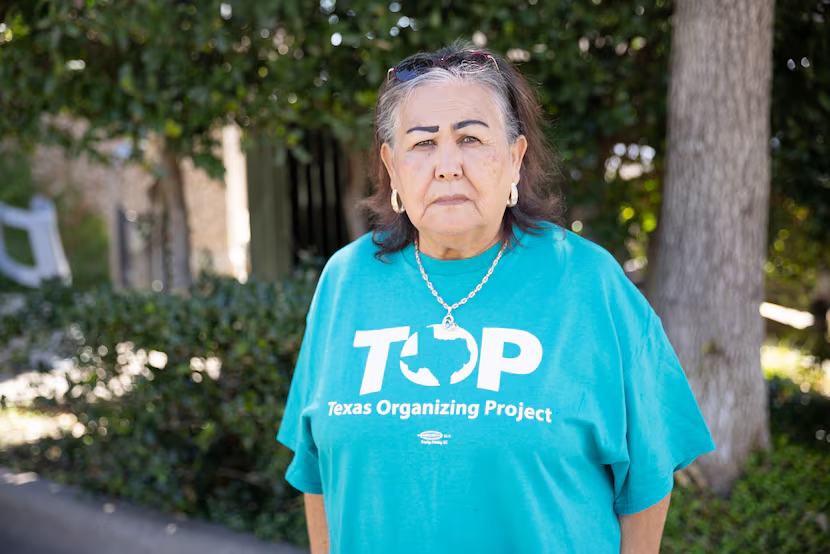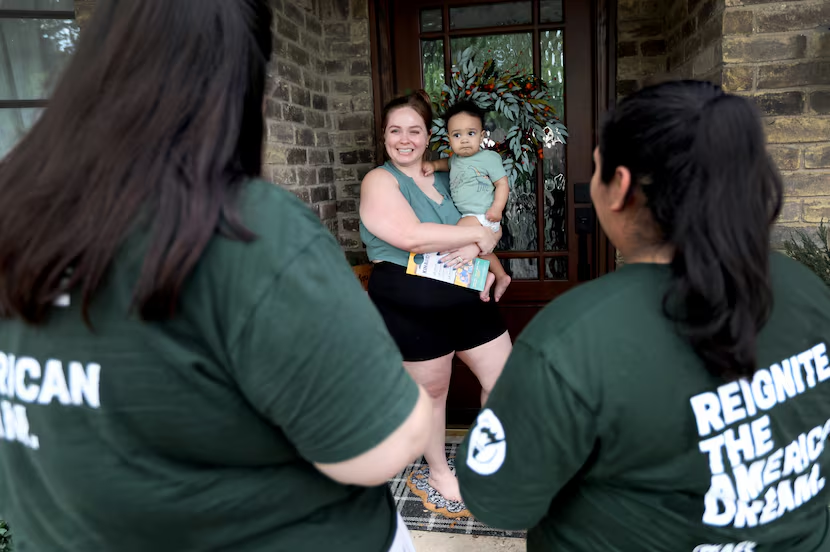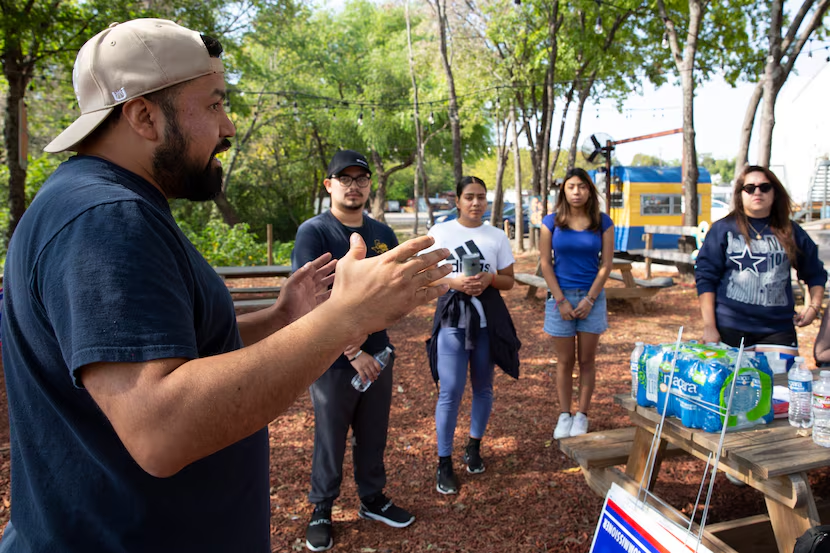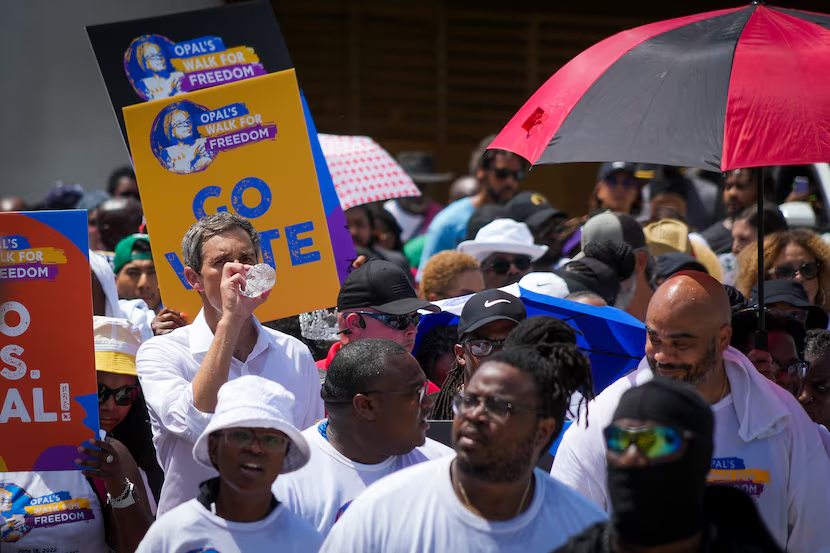Almost 10 years ago, Guadalupe Ruiz put on her favorite outfit, walked into a southern Dallas polling place and — for the first time in her life — voted.
Then a 60-year-old grandmother, Ruiz was coaxed to the polls by Texas Organizing Project, a progressive group that urged her to use her vote to improve health care in a state with the highest percentage of residents without health insurance. She attended one of the group’s voter turnout rallies before voting at a North Oak Cliff polling place.
“I wanted Medicaid expansion,” said Ruiz, now 69. “I’m a diabetic and that’s the issue that got me to vote. I was looking for someone who would support Medicaid expansion, and Wendy Davis was the one who would do it.”
Before casting her first ballot, Ruiz was invisible to the state’s political parties, which lack the time, money and resources to court Texans who have opted out of the political system. No longer seen as a lost cause, Ruiz gets deluged with political mail and phone calls every election season.
Candidates, campaigns and political parties are forced to focus their voter turnout efforts on reliable voters, a political reality that reduces opportunities to entice nonvoters into participating in a process that determines how elected leaders spend tax dollars that could help them and their neighborhoods.
On Tuesday, The Dallas Morning News will launch “Back To The Ballot,” an effort to educate voters on the election process and explore the causes of voter apathy and potential solutions.
Analysts say there are a number of reasons residents choose not to vote. They may not have enough information about the elections, are distrustful of the system or don’t think their vote will make a difference.
It takes multiple personal contacts with infrequent voters, sometimes up to 10 times knocking on their doors, to get them to the polls, political operatives say. That often proves too costly and time consuming, so campaigns focus their efforts on tried-and-true voters.
“That’s been the standard mode of operation for political parties as long as political parties have been around,” said Joyce LeBombard, president of the nonpartisan League of Women Voters of Texas. “That’s a problem for the underserved and the underrepresented.”
Representatives from both major parties acknowledge nonvoters are a low priority in their turnout efforts.
“The chances of low-propensity voters coming out to participate is typically low,” said Jeff Dalton, a Democratic political consultant based in North Texas. “I would say I’m hyper realistic about my own personal ability to generate new votes. I’m almost always more concerned about persuading the people that are going to vote.”

Dalton has tracked North Texas voter registration and turnout statistics for recent elections.
For the 2022 general election, Dallas, Collin, Grayson, Hunt, Kaufman and Rockwall counties had a combined 124,358 new registered voters in the previous year. Of the total, 40,324 (32%) cast ballots.
Turnout from registered voters dipped for the 2024 Democratic and Republican primaries, Dalton said. Of the 117,914 people who registered in the year prior to the March 5 primaries, only 7,960, or 7%, cast a ballot in either party’s primary.
The lower rate of participation is not surprising because primaries draw much less interest, Dalton said.
Given the interest in the 2024 presidential election, higher turnout from infrequent or new voters is possible.
In Dallas, Collin, Grayson, Hunt, Kaufman and Rockwall counties combined, 113,562 have registered since Oct. 7, 2023. The deadline to register for the Nov. 5 election is Oct. 7. Dalton said that “assuming another 10,000 people register before the deadline,” these counties should have about 125,000 new voters registered in the prior year before the election.
Matthew Langston is a Republican consultant based in Austin. Like Dalton, he said most voter turnout models involve candidates interacting with tried-and-true voters.
“The best rate of return is to focus on people that have a history of voting,” Langston said. “You have to be an extremely well-funded campaign to layer-in residents with no history of voting.”

Reaching nonvoters also can be unpredictable. No candidate wants to lure a voter to the polls who may cast a ballot for their opponent. Partisan voter registration drives are typically confined to areas where the candidates or parties feel they will gain political support.
“It’s mostly talking heads that go out there and describe this mythical person that all of a sudden is going to start voting and you’re going to know how they will vote,” Langston said. “Candidates and consultants follow patterns. It’s very rare that your history changes when you’re voting.”
There are examples of political parties attracting or reaching out to nonvoters in historic ways, including Barack Obama in 2008 and 2012, Donald Trump in 2016 and Beto O’Rourke in 2018.
But candidates like that aren’t the norm.
On a more consistent basis, groups independent of political parties are more likely to make reaching out to nonvoters a priority.
It’s tough work.
“The people that we want to inspire to participate at the ballot box and beyond are folks that aren’t typically sought after, or aren’t typically prioritized by the establishment or traditional political apparatus,” said Brianna Brown, co-executive director of the Texas Organizing Project.
“We believe that in order to transform how democracy works in Texas, we need to expand the electorate, and in particular the electorate of color — Black and Latino Texans — in order to deliver a different future,” Brown said.
Ramiro Luna, co-founder and executive director Somos Tejas, said the nonprofit voter engagement group has similar goals.
“Basically what happens in the science of elections is that you invest your money into the high voting turnout communities or the high-capacity voters. You don’t take into account the other communities,” Luna said. “Our nonprofit does the exact opposite. We bring attention and resources and focus to these communities.”
“Voting deserts,” he said, tend to be in the same underserved areas as food deserts and locations that have less access to broadband.
“It’s just a matter of, are we doing enough to invest in these communities?” Luna said.
Unlike progressive groups, Texas Republicans tend to focus less on finding new voters, instead directing efforts toward rallying voters who have elected an unbroken string of statewide GOP candidates since the mid-1990s. There are times, however, when new voter outreach is necessary.
“The low-propensity voters are sought after when there’s money and resources available to turn them out, and when it’s a competitive election,” said GOP strategist Dave Carney. “It’s all about math. It’s all about how many votes you need to win.”

It’s not a problem of voter registration
More people are registered to vote in Texas than ever.
Secretary of State Jane Nelson says there are nearly 18 million registered voters in Texas, up from 13.6 million in 2014, the same year Ruiz voted for Davis, who lost the race for governor to Republican Greg Abbott.
About 82% of eligible Texans are registered to vote.
Even so, only 18% of registered voters participated in the Texas Republican and Democratic primaries last March — well under the national rate of 23%.
“At first it didn’t interest me because I felt people make all kinds of promises, and then when you vote for them, they don’t deliver,” Ruiz said of why she was a nonvoter.
LeBombard, president of the League of Women Voters of Texas, said the difficulty lies in getting eligible voters to the polls.
“We hear over and over that, ‘I don’t vote because I don’t know who to vote for,’ or ‘I don’t know how to vote,’” she said.
Motivating nonvoters is labor intensive. Effectively canvassing neighborhoods requires multiple face-to-face contacts with voters, said former state Rep. Lorraine Birabil, D-Dallas.
“It takes at least three touches to get someone out to vote. When you talk about somebody who is an emerging voter, you’re probably talking about seven to 10 touches,” Birabil said.
“A lot of times, political parties just don’t have the funding to spend the time and effort in getting that voter to convert from low propensity to an actual voter,” she said.
Some local parties are trying to make a difference.
Dallas County Democrats are making a seven-figure investment in going after nonvoters, said Randall Bryant, director of the local party’s coordinated campaign for November.
“I would say 80% of our resources in the Dallas County Democratic Party are focused right on going after low-propensity voters in these high-density areas that are all across the county,” he said. “For so long low-propensity voters have been very identifiable in the southern sector, but we’re looking at a lot in the north and western portion of the county, as well as Garland, Grand Prairie and Irving.”
Making low-participation voters feel connected
O’Rourke, a former congressman from El Paso who has run for Senate, president and governor, said he realized after his unsuccessful 2022 campaign against Abbott that more should be done to get people to the polls.
Powered by People, a group he founded, began by focusing on registering voters to build support for Democrats and candidates pushing a progressive agenda.
O’Rourke’s group now focuses more on turnout. When Powered by People registers someone to vote, a volunteer seeks permission to remain in communication until election day.
“We registered hundreds of thousands of people in 2020, but we just registered them and we basically said, ‘Good luck, thanks for getting registered,’” O’Rourke said. “My bet is that on election day we’re going to see much higher turnout from those folks that we registered and stayed in touch with.”
Texas Organizing Project stays in contact with voters year-round, not just during election season. The group seeks to empower voters to have a voice on issues related to criminal justice reform, voting rights, affordable housing, immigration, health care and climate change.
“Our charge is to make sure that people feel a really intimate connection between going to the ballot box and voting and how your life, how the material conditions of your life changes for folks who are on the margins,” Brown said.
Advocates say voting can be addictive.
“The more you vote, the more you’re encouraged to vote, right? So you become a frequent voter,” Brown said. “You then start getting mail. You start getting on the radar of candidates and political field operations and it starts to take care of itself.”
Luna said voter outreach works when the proper investment is made.
In 2020, during the coronavirus pandemic, Somos Tejas developed a pilot project that studied how two low-voting precincts in West Oak Cliff would be affected by an increase in outreach. Operatives tracked voters for more than a year, discussing how to get vaccines, access broadband and connect with city services. They also provided voter information and, Luna said, turnout in the 2021 city council races increased by 150% over previous city elections.

“It’s just a matter of are we doing enough to invest in these communities and enough to right the sins of the past?” Luna added. “Unfortunately, we’re not going to be able to get the political parties to do so.”
Americans for Prosperity, a conservative group, is working to reach low-participation voters in the Dallas area. That effort, concentrated in districts where both parties are competitive, includes knocking on the doors of residents who have voted once in a Democratic primary — on the chance they are not hard-core Democrats — as well as those who voted once or twice in a previous GOP primary.
“We’re just trying to identify these folks and understand where they are on the issues, because no one knows anything about them,” said Genevieve Collins, Texas director of AFP. “The goal is to expand the tent.”
Another group, NextGen America, is trying to reach younger nonvoters on college campuses and elsewhere. Young voters will soon be the largest voting bloc in the country, said Antonio Arellano, vice president of communications.
Outreach for women includes Hot Girls Vote, a takeoff on entertainer Megan Thee Stallion’s 2019 hit Hot Girl Summer. For young men, there’s MVP – Men’s Voting Power.
“The electorate in Texas is incredibly young and blacker and browner than ever before because of the recent demographic shifts,” Arellano said. “This presents a unique opportunity for communities of color and young voters to not only have a seat at the table but set the agenda.”
While presidential races are the most popular and can drive turnout, mobilizing voters is an inexact science.
“The biggest variable is whether or not there’s some amazing, highly competitive race at the top of the ballot, potentially Kamala Harris vs. Donald Trump,” Dalton said. “If people are really plugged in and they think their vote is going to matter, it could drive turnout, but those things are beyond the control of the average local campaign, or even like state or district campaigns.”
Ruiz, who has become a voting rights advocate focusing on getting Texas residents affordable health insurance, said she is excited about the prospect of voting in November.
“It’s good to vote,” she said. “Without voting, it’s hard to get what you want.”


